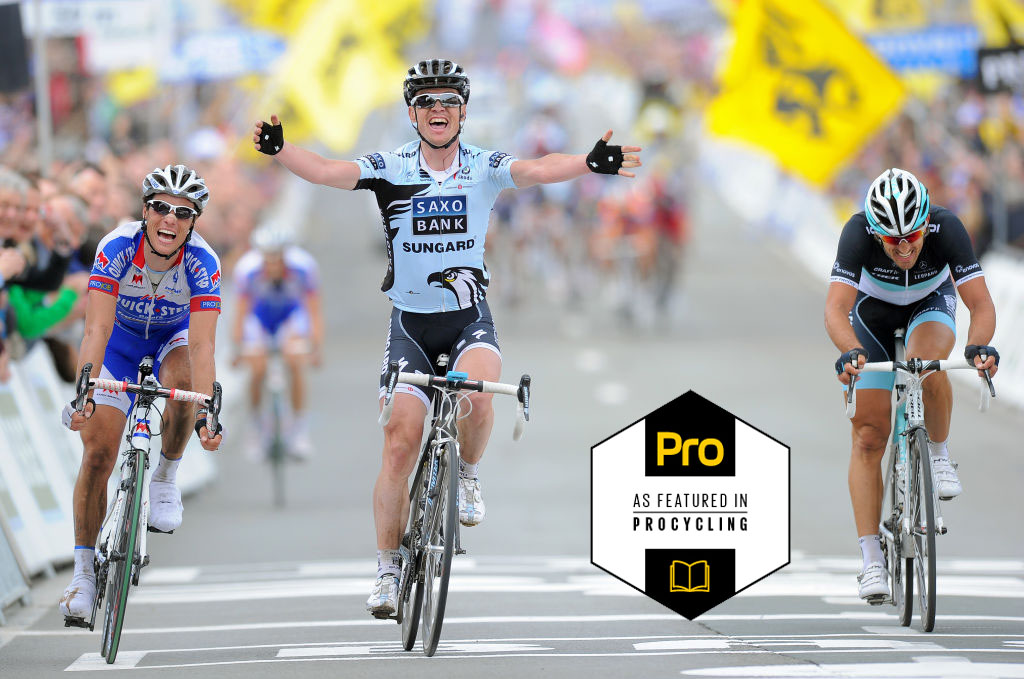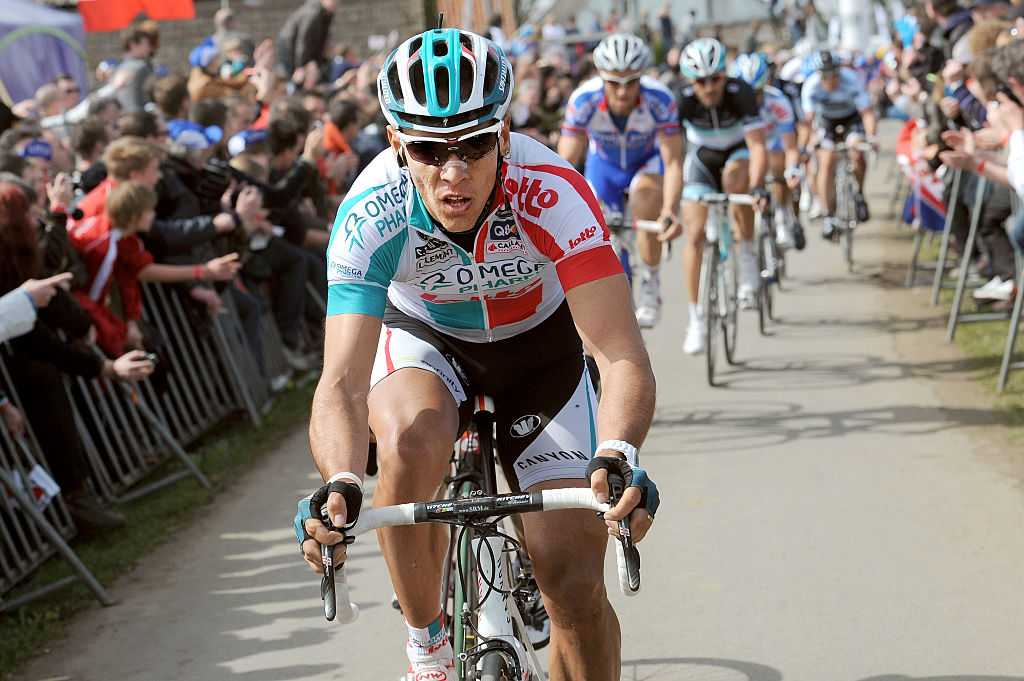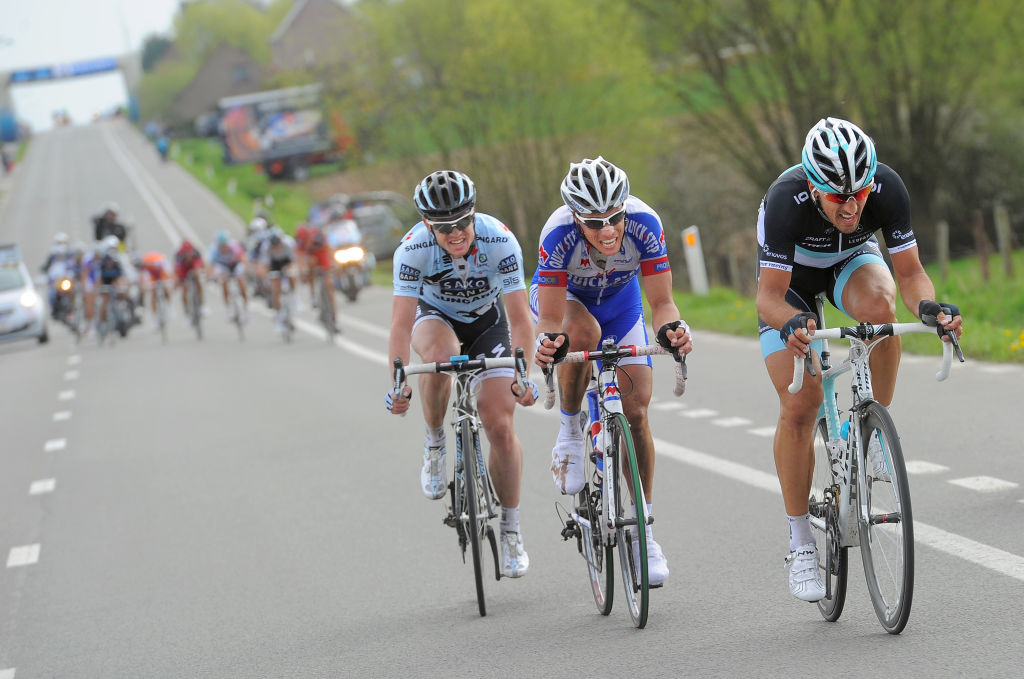Tour of Flanders 2011: The great race
Procycling magazine looks back at one of the best one-day races of all-time

Procycling magazine: the best writing and photography from inside the world's toughest sport. Pick up your copy now in all good newsagents and supermarkets, or get a Procycling subscription.
The 2011 Tour of Flanders pitted an epic crushing attack by Fabian Cancellara against the wiles and race craft of Nick Nuyens. But this race, the last to finish in Ninove, also represented the way cycling changes and adapts.
This article was taken from Procycling magazine, issue 264.
There was a moment early on in the 2011 Tour of Flanders when it looked as if the race had been killed stone dead. The trigger was pulled by Fabian Cancellara, the reigning champion. In 2010, 12 months previously, he and Tom Boonen had attacked over the Molenberg with 45km to go, then he’d dispatched the Belgian on the Muur in such violent fashion that even now, almost a decade later, there’s a vociferous corner of the internet occupied by motor-doping truthers convinced that there was more than muscle power turning his pedals. Twelve months on, it looked like history might repeat itself.
In fact, it looked as if Cancellara would crush the opposition even more decisively. It had been Boonen who started the move, using the drag out of the Haaghoek cobbles to attack, taking Cancellara with him.
But as the pair picked their way through a group of previous escapees on the Leberg, Cancellara surged and Boonen was unable to match him. Boonen got marooned with a group who had no intention of helping him close the gap to Cancellara, while the Swiss set about reducing the gap between himself and Boonen’s team-mate Sylvain Chavanel, alone at the front, and the rest of the race. (What Boonen had been doing attacking when he’d had a team-mate up the road is uncertain, but, he had ample opportunity to reflect on the wisdom of his manoeuvre, as Cancellara disappeared over the horizon.) By Tenbossestraat, the 16th of 18 bergs and 15km after Cancellara’s attack, the gap between Cancellara and Chavanel and a 50-strong peloton was 65 seconds.
It looked like the race was over. However, we are sometimes guilty in cycling of mistaking this year’s race for last. Sometimes riders do this as well.
Get The Leadout Newsletter
The latest race content, interviews, features, reviews and expert buying guides, direct to your inbox!
Cycling, more than any other sport, lives in both the present and the past. You only have to look at the esteem with which the Tour de France held the late Raymond Poulidor to understand that. When the Tour visits a town, it often wheels out the local ex-pro to present the jerseys. The showers of Paris-Roubaix and the bends of Alpe d’Huez are decorated with plaques listing previous winners. The Tour of Flanders even has its own museum, in which a stack of cobbles is arranged, each with the name of a winner.
Usually, this is an asset - cycling’s traditions are part of the sport’s marketing. In the case of the Tour of Flanders, this is manifested in a celebration of the tough and gritty nature of racing on cobbles – the Tour may be contested by bronzed, slight figures who can dance up the mountains but the cobbled classics are for broad-shouldered thugs with square jaws and an imperviousness to bad weather. The riders who dominated in the early years of the race were known as the ‘Flandriens’ - a description of their Flemish roots, but also taken to encompass their stoicism, toughness and humility. The Belgian races are special, and the fact that they are horrible to ride is part of the appeal.
We can look at the faces of the riders in the modern peloton, covered in mud thrown up from the road, and those of the ‘Flandriens’ of the 1940s and 1950s, and see that what connects them is much stronger than what separates them. So Johan Museeuw, who won the Ronde three times in the 1990s, might have had a modern bike and a modern pay packet, but he was still cast in the same tough, Flemish mould as the original ‘Flandrien’, Briek Schotte, who won twice in the 1940s.
Cycling’s traditions are also a political football. Modernisers suggest that the sport, funded for much of its existence by sponsors who wanted to bask in the reflected success of winning riders and by generous benefactors, needs a new business model and new sources of money if it is to survive and prosper.
The 2011 Tour of Flanders sat exactly on this fault line between cycling’s past and its present. It happened to be the last held using the ‘traditional’ finale, which climbed the Muur and Bosberg en route to the finish in Ninove. When it was announced that the 2012 race and those after it would feature a new route, based around laps and climbing the Oude Kwaremont multiple times, and finishing in Oudenaarde, purists were outraged.

Of course, the decision by Flanders Classics, who own the race, was partly a financial one and a deliberately modernising one. Ninove’s contract for hosting the finish was up, Oudenaarde had bid the most attractive sum to replace it, and - related - there was a dispute about the city of Geraardsbergen, above which sits the Muur, setting up hospitality tents independently of the race. The new structure initially avoided Geraardsbergen altogether and allowed Flanders Classics to establish their own, presumably lucrative, hospitality tents in the fields alongside the top half of the Kwaremont climb.
If you wanted a convenient metaphor for the priorities of the organisers – the money or the race – you might look no further than the Kwaremont. Andreas Klier, a former runner-up in the Tour of Flanders and the DS in the car of Alberto Bettiol, the winning rider in 2019, said that the hospitality tents had even changed the nature of the climb. The prevailing southwest wind used to blow across the drag to the top of the Kwaremont, making it a very difficult point in the race; these days the crosswind has been taken out of the equation by the tents. Any big football club knows that the corporate seats bring in more money, but at the cost of atmosphere – the question is, where should the balance be?
Tradition is a funny thing in cycling, however. You could say that the traditional Muur-Bosberg-Ninove finish was one of the defining aspects of the race, yet the race only started finishing in Ninove in 1973 after more than half a century in various suburbs of Gent. The Bosberg didn’t appear until 1975, and the race took different routes up and over the Muur until settling in 1998. Nothing is ever set in stone in bike racing.
Which brings us back to 2011. The resemblance to 2010 lasted for precisely 15km after Cancellara’s attack, before he got a real-life lesson in how things can change, in spite of seeming to be set in stone. The Greek myths teach us that hubris is always punished with retribution by nemesis. In this case Cancellara’s nemesis came in the red and black colours of BMC, along with a mild case of the bonk.
The Swiss rider’s Leopard-Trek team missed a feed and it took Cancellara several kilometres to get a bottle, leaving him short of energy. Though the peloton was only about 50 riders strong and most of the leaders were by now quite isolated, seven of BMC’s eight riders had made it. Nobody else had the numbers or strength to make headway, so they got to work and Cancellara’s lead, which had peaked at over a minute, melted away as he and Chavanel climbed through Geraardsbergen to the foot of the Muur. Just when it seemed the race had gone away, it came back together, and then, incredibly, detonated again under pressure from Cancellara.
As the leading riders made contact, he went away again, pulling a small group clear, then another small group, and then another couple of riders, until eventually, on the approach to the Bosberg, a dozen riders coalesced into a group at the front.
A rolling bar-room brawl ensued: Philippe Gilbert attacked on the Bosberg and went clear, but was chased down in a desperate pursuit. Alessandro Ballan tried next. Then Nick Nuyens, briefly.
Then Geraint Thomas. Then Juan Antonio Flecha. Then Sebastian Langeveld. None could get away; each was chased down. The crucial attack came with just over three kilometres to go, from Cancellara, chased in turn by Chavanel and Nuyens.
The move simultaneously killed the chances of both Cancellara and Boonen. Boonen was the best sprinter, but was left stuck with the pursuers while his team-mate Chavanel, who’d spent a huge amount of energy in 100km worth of escape had little chance in the sprint. Cancellara was also vulnerable – not to Chavanel but to fast finisher Nuyens, who’d been hidden for virtually the whole race and was barely mentioned by the commentators until the finishing straight, where he made short work of his rivals.

Nuyens’s victory reminded us that bike races are not always won by the strongest rider and that tactics, patience and a little bit of luck give the sport multiple levels of nuance that wouldn’t exist if it were a pure test of strength.
It doesn’t always play well with the winner’s peers or the public – Boonen sniffed that Nuyens had hidden away for the whole race, and when the readers of Het Nieuwsblad were polled in 2013 about their favourite editions of the Ronde, the two that received the most votes were 1985, when Eric Vanderaerden won in horrendous conditions, and 1969 when Eddy Merckx won in equally horrendous conditions. In those races, the strongest riders had overcome terrible weather and won alone. In 2011, Chavanel and Cancellara had provided the epic dimension, with the length of the Frenchman’s break, and the sheer force of the Swiss attacks, but the victory went not to either of these two, but to Nuyens, who showed a politician’s understanding of his rivals’ vulnerabilities and timing rather than super strength in epic weather.
However, Nuyens’s win told us a lot about bike racing. On a granular level, there was that reminder that a strong head will often trump strong legs. But it also reflected the continuing tension in the sport between tradition and modernity. The history of the classics is rich with tales of the tough, gritty cobbled races, and the tough, stoic characters who win them.
Yet Nuyens didn’t fit that stereotype at all. He has a degree in media science and communication and his parents worked in the diamond industry. Then again, his grandparents were farmers. Sometimes old and new coexist quite happily in cycling.
Procycling magazine: the best writing and photography from inside the world's toughest sport. Pick up your copy now in all good newsagents and supermarkets, or get a Procycling subscription.
Follow @Procycling_mag
Edward Pickering is Procycling magazine's editor. He graduated in French and Art History from Leeds University and spent three years teaching English in Japan before returning to do a postgraduate diploma in magazine journalism at Harlow College, Essex. He did a two-week internship at Cycling Weekly in late 2001 and didn't leave until 11 years later, by which time he was Cycle Sport magazine's deputy editor. After two years as a freelance writer, he joined Procycling as editor in 2015. He is the author of The Race Against Time, The Yellow Jersey Club and Ronde, and he spends his spare time running, playing the piano and playing taiko drums.